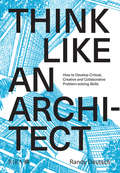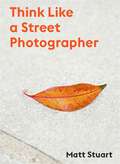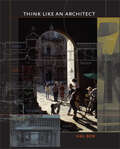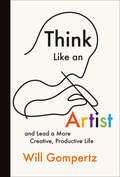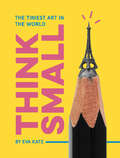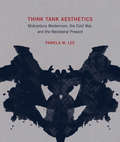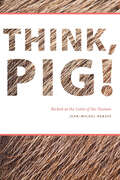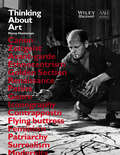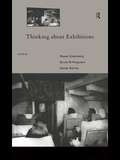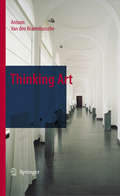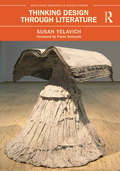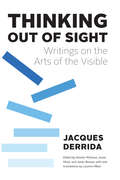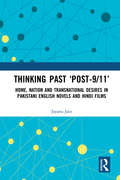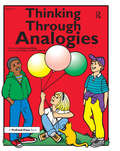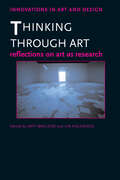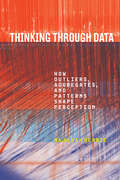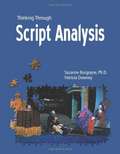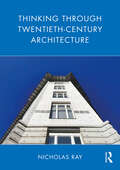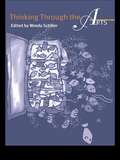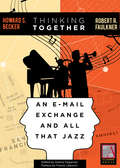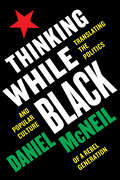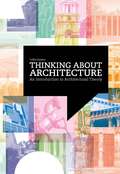- Table View
- List View
Think Like An Architect: How to develop critical, creative and collaborative problem-solving skills
by Randy DeutschDo you know how to think like an architect? Do you know why you should? How do you make sure that you have the critical thinking tools necessary to prosper in your academic and professional career? This book gives you the answers. Architects have a valuable and critical set of multiple thinking types that they develop throughout the design process. In this book, Randy Deutsch shows readers how to access those thinking types and use them outside pure design thinking – showing how they can both solve problems but also identify the problems that need solving. To think the way the best architects do. With a clear, driving narrative, peppered with anecdote, stories and real-life scenarios, this book will future-proof the architectural student. Change is coming in the architecture profession, and this is a much-needed exploration of the critical thinking skills that architects have in abundance, but that are not taught well enough within architecture schools. These skills are crucial in being able to respond agilely to a future that nobody is quite sure of.
Think Like a Street Photographer
by Derren Brown Matt Stuart'Never does that old maxim "the harder I practice, the luckier I get" ring truer.' - Matt StuartStreet photography may look like luck, but you have to get out there and hone your craft if you want to shake up those luck vibes. Matt Stuart never goes out without his trusty Leica and, in a career spanning twenty years, has taken some of the most accomplished, witty and well-known photographs of the streets.From understanding how to be invisible on a busy street, to anticipating a great image in the chaos of a crowd, Matt Stuart reveals in over 20 chapters the hard-won skills and secrets that have led to his greatest shots. He explains his purist and uniquely playful approach to street photography leaving the reader full of ideas to use in their own photography. Illustrated throughout with 100 of Stuart's images, this is a unique opportunity to learn from one of the finest street photographers around.
Think Like a Street Photographer
by Derren Brown Matt Stuart'Never does that old maxim "the harder I practice, the luckier I get" ring truer.' - Matt StuartStreet photography may look like luck, but you have to get out there and hone your craft if you want to shake up those luck vibes. Matt Stuart never goes out without his trusty Leica and, in a career spanning twenty years, has taken some of the most accomplished, witty and well-known photographs of the streets.From understanding how to be invisible on a busy street, to anticipating a great image in the chaos of a crowd, Matt Stuart reveals in over 20 chapters the hard-won skills and secrets that have led to his greatest shots. He explains his purist and uniquely playful approach to street photography leaving the reader full of ideas to use in their own photography. Illustrated throughout with 100 of Stuart's images, this is a unique opportunity to learn from one of the finest street photographers around.
Think Like an Architect (Roger Fullington Series in Architecture)
by Hal BoxAn award-winning architect and educator demystifies the process of making architecture and explains why good architectural design matters. The design of cities and buildings affects the quality of our lives. Making the built environments in which we live, work, and play useful, safe, comfortable, efficient, and as beautiful as possible is a universal quest. What many don&’t realize is that professional architects design only about five percent of the built environment. While much of what non-architects build is beautiful and useful, the ugliness and inconveniences that blight many urban areas demonstrate that an understanding of good architectural design is vital for creating livable buildings and public spaces. To help promote this understanding among non-architects and those considering architecture as a profession, award-winning architect and professor Hal Box explains the process from concept to completed building, using real-life examples to illustrate the principles involved. To cause what we build to become architecture, we have three choices: hire an architect, become an architect, or learn to think like an architect. In this book, organized as a series of letters to students and friends, Box covers: what architecture should be and dohow to look at and appreciate good buildingshow to understand the design process, work with an architect, or become an architectan overview of architectural history, with lists of books to read and buildings to seepractical guidance about what goes into constructing a buildingan architect&’s typical training and career pathhow architecture relates to the citywhere the art of architecture is headedwhy good architecture matters
Think Like an Artist: And Lead a More Creative, Productive Life
by Will GompertzLearn how to jump-start your imagination to conjure up innovative, worthwhile ideas with help from some of the greatest artists in the world. How do artists think? Where does their creativity originate? How can we, too, learn to be more creative? BBC Arts Editor Will Gompertz seeks answers to these questions in his exuberant, intelligent, witty, and thought-provoking style. Think Like an Artist identifies ten key lessons on creativity from artists that range from Caravaggio to Warhol, Da Vinci to Ai Weiwei, and profiles leading contemporary figures in the arts who are putting these skills to use today. After getting up close and personal with some of the world’s leading creative thinkers, Gompertz has discovered traits that are common to them all. He outlines basic practices and processes that allow your talents to flourish and enable you to embrace your inner Picasso—no matter what you do for a living. With wisdom, inspiration, and advice from an author named one of the fifty most original thinkers in the world by Creativity magazine, Think Like an Artist is an illuminating view into the habits that make people successful. It’s time to get inspired and think like an artist!
Think Small: The Tiniest Art in the World
by Eva KatzTwenty-four artists create stunning miniature art with almonds, matchsticks, test tubes, and more in this fabulous collection.From the astounding to the downright unbelievable, this little volume of mind-blowingly tiny artworks showcases the talents of twenty-four artists from around the globe. Makers, crafters, art enthusiasts, and fans of tiny works will delight in this homage to all things infinitesimally small. Replete with more than two hundred images of miniature masterpieces— including intricately carved pencil leads, fantastical dioramas floating in test tubes, ceramic vases smaller than a six-sided die, crystal cityscape shells designed for hermit crabs, and more—Think Small is sure to make a big impression.Praise for Think Small“Marvel at the extreme dexterity and patience of 24 contemporary artists who painstakingly labor to create artworks at minuscule scale in this adorably tiny coffee-table book. From Hasan Kale, who somehow turns halved almonds and matchstick heads into canvases, to Salavat Fidai, who carefully carves pencils into tiny lead sculptures, each diminutive piece offers mind-blowing demonstrations of craft, skill, and artistic vision.” —Artnet“Spectacular . . . . There are embroidered portraits no larger than a quarter, intricate landscapes painted on lockets, and exquisite sculptures carved into the tips of pencils . . . . This is a fun, accessible, and compact book that both casual and enthusiastic art fans will enjoy.” —Publishers Weekly
Think Tank Aesthetics: Midcentury Modernism, the Cold War, and the Neoliberal Present
by Pamela M. LeeHow the approaches and methods of think tanks—including systems theory, operational research, and cybernetics—paved the way for a peculiar genre of midcentury modernism. In Think Tank Aesthetics, Pamela Lee traces the complex encounters between Cold War think tanks and the art of that era. Lee shows how the approaches and methods of think tanks—including systems theory, operations research, and cybernetics—paved the way for a peculiar genre of midcentury modernism and set the terms for contemporary neoliberalism. Lee casts these shadowy institutions as sites of radical creativity and interdisciplinary practice in the service of defense strategy. Describing the distinctive aesthetics that emerged from such institutions as the RAND Corporation, she maps the multiple and overlapping networks that connected nuclear strategists, mathematicians, economists, anthropologists, artists, designers, and art historians.Lee recounts, among other things, the decades-long colloquy between Albert Wohlstetter, a RAND analyst, and his former professor, the famous art historian Meyer Schapiro; the anthropologist Margaret Mead's deployment of innovative visual aids that recall midcentury abstract art; and the combination of cybernetics and modernist design in an “Opsroom” for the short-lived socialist government of Salvador Allende in 1970s Chile (and its restaging many years later as a work of art). Lee suggests that we think of these connections less as disciplinary border crossings than as colonization of the specific interests of arts by the approaches and methods of the sciences. Hearing the echoes of think tank aesthetics in today's pursuit of the interdisciplinary and in academia's science-infused justification of the humanities, Lee wonders what territory has been ceded in a laboratory approach to the arts.
Think, Pig!: Beckett at the Limit of the Human
by Jean-Michel RabatéThis book examines Samuel Beckett’s unique lesson in courage in the wake of humanism’s postwar crisis—the courage to go on living even after experiencing life as a series of catastrophes.Rabaté, a former president of the Samuel Beckett Society and a leading scholar of modernism, explores the whole range of Beckett’s plays, novels, and essays. He places Beckett in a vital philosophical conversation that runs from Bataille to Adorno, from Kant and Sade to Badiou. At the same time, he stresses Beckett’s inimitable sense of metaphysical comedy.Foregrounding Beckett’s decision to write in French, Rabaté inscribes him in a continental context marked by a “writing degree zero” while showing the prescience and ethical import of Beckett’s tendency to subvert the “human” through the theme of the animal. Beckett’s “declaration of inhuman rights,” he argues, offers the funniest mode of expression available to us today.
Thinking About Art: A Thematic Guide to Art History
by Penny HuntsmanThinking about Art explores some of the greatest works of art and architecture in the world through the prism of themes, instead of chronology, to offer intriguing juxtapositions of art and history. The book ranges across time and topics, from the Parthenon to the present day and from patronage to ethnicity, to reveal art history in new and varied lights. With over 200 colour illustrations and a wealth of formal and contextual analysis, Thinking about Art is a companion guide for art lovers, students and the general reader, and is also the first A-level Art History textbook, written by a skilled and experienced teacher of art history, Penny Huntsman. The book is accompanied by a companion website at www.wiley.com/go/thinkingaboutart.
Thinking About Exhibitions
by Bruce W. Ferguson Reesa Greenberg Sandy NairneAn anthology of writings on exhibition practice from artists, critics, curators and art historians plus artist-curators. It addresses the contradictions posed by museum and gallery sited exhibitions, as well as investigating the challenge of staging art presentations, displays or performances, in settings outside of traditional museum or gallery locales.
Thinking Art
by Antoon Van BraembusscheIn the twentieth century, avant-garde movements have pushed the concept of art far beyond its traditional boundaries. In this dynamical process of constant renewal the prestige of thinking about art as a legitimizing practice has come to the fore. So it is hardly surprising that the past decades have been characterized by a revival or even breakthrough of philosophy of art as a discipline. However, the majority of books on aesthetics fail to combine a systematical philosophical discourse with a real exploration of art practice. Thinking Art attempts to deal with this traditional shortcoming. It is indeed not only an easily accessible and systematic account of the classical, modern and postmodern theories of art, but also concludes each chapter with an artist's studio in which the practical relevance of the discussed theory is amply demonstrated by concrete examples. Moreover, each chapter ends with a section on further reading, in which all relevant literature is discussed in detail. Thinking Art provides its readers with a theoretical framework that can be used to think about art from a variety of perspectives. More particularly it shows how a fruitful cross-fertilization between theory and practice can be created. This book can be used as a handbook within departments of philosophy, history of art, media and cultural studies, cultural history and, of course, within art academies. Though the book explores theories of art from Plato to Derrida it does not presuppose any acquaintance with philosophy from its readers. It can thus be read also by artists, art critics, museum directors and anyone interested in the meaning of art.
Thinking Color in Space: Positions, Projects, Potentials
by Kerstin Schultz Hedwig Wiedemann-Tokarz Eva Maria HerrmannThe interaction between color and architecture determines our perception of space, and defines the tectonic relationships. In their book Thinking Color in Space: Positions, Projects, Potentials, authors Kerstin Schultz, Hedwig Wiedemann-Tokarz, and Eva Maria Herrmann explore the fascinating spatial potential of color. <p><p> The multi-layered dimensions of interpretation in the experience of color are design and communication means which, however, are often not fully used—color oscillates between autonomy and functional purpose, and should be understood as a distinct material that can be used as part of the design. Thinking Color in Space: Positions, Projects, Potentials focuses both on the tangible aspects and design criteria of color, and on its indeterminate nature and its experience value. Using examples in art and architecture, the spatial interdependency of color is illustrated, as is its interaction with structure, light, and geometry.
Thinking Contemporary Curating
by Terry Smith Kate FowleWhat is contemporary curatorial thought? Current discourse on the topic is heating up with a new cocktail of bold ideas and ethical imperatives. these include: cooperative curating, especially with artists; the reimagination of museums; curating as knowledge production; the historicization of exhibitionmaking; and commitment to extra-artworld participatory activism. Less obvious, but increasingly of concern, are issues such as rethinking spectatorship, engaging viewers as co-curators and the challenge of curating contemporaneity itself. In these five essays, art historian and theorist Terry Smith surveys the international landscape of current thinking by curators; explores a number of exhibitions that show contemporaneity in recent, present and past art; describes the enormous growth world wide of exhibition infrastructure and the instability that haunts it; re-examines the contribution of artist-curators and questions the rise of curators utilizing artistic strategies; and, finally, assesses a number of key tendencies in curating as responses to contemporary conditions. Thinking Contemporary Curating is the first book to comprehensively chart the variety of practices of curating undertaken today, and to think through, systematically, what is distinctive about contemporary curatorial thought.This is the eBook edition of Thinking Contemporary Curating, print form to be published in September 2012.
Thinking Design Through Literature (Routledge Research in Design Studies)
by Susan YelavichThis book deploys literature to explore the social lives of objects and places. The first book of its kind, it embraces things as diverse as escalators, coins, skyscrapers, pottery, radios, and robots, and encompasses places as various as home, country, cities, streets, and parks. Here, fiction, poetry, and literary non-fiction are mined for stories of design, which are paired with images of contemporary architecture and design. Through the work of authors such as César Aires, Nicholson Baker, Lydia Davis, Orhan Pamuk, and Virginia Woolf, this book shows the enormous influence that places and things exert in the world.
Thinking Out of Sight: Writings on the Arts of the Visible (The\france Chicago Collection)
by Jacques DerridaJacques Derrida remains a leading voice of philosophy, his works still resonating today—and for more than three decades, one of the main sites of Derridean deconstruction has been the arts. Collecting nineteen texts spanning from 1979 to 2004, Thinking out of Sight brings to light Derrida’s most inventive ideas about the making of visual artworks. The book is divided into three sections. The first demonstrates Derrida’s preoccupation with visibility, image, and space. The second contains interviews and collaborations with artists on topics ranging from the politics of color to the components of painting. Finally, the book delves into Derrida’s writings on photography, video, cinema, and theater, ending with a text published just before his death about his complex relationship to his own image. With many texts appearing for the first time in English, Thinking out of Sight helps us better understand the critique of representation and visibility throughout Derrida’s work, and, most importantly, to assess the significance of his insights about art and its commentary.
Thinking Past ‘Post-9/11’: Home, Nation and Transnational Desires in Pakistani English Novels and Hindi Films
by Jayana JainThis book offers new ways of constellating the literary and cinematic delineations of Indian and Pakistani Muslim diasporic and migrant trajectories narrated in the two decades after the 9/11 attacks. Focusing on four Pakistani English novels and four Indian Hindi films, it examines the aesthetic complexities of staging the historical nexus of global conflicts and unravels the multiple layers of discourses underlying the notions of diaspora, citizenship, nation and home. It scrutinises the “flirtatious” nature of transnational desires and their role in building glocal safety valves for inclusion and archiving a planetary vision of trauma. It also provides a fresh perspective on the role of Pakistani English novels and mainstream Hindi films in tracing the multiple origins and shifts in national xenophobic practices, and negotiating multiple modalities of political and cultural belonging. It discusses various books and films including The Reluctant Fundamentalist, Burnt Shadows, My Name is Khan, New York, Exit West, Home Fire, AirLift and Tiger Zinda Hai. In light of the twentieth anniversary of 9/11 attacks, current debates on terror, war, paranoid national imaginaries and the suspicion towards migratory movements of refugees, this book makes a significant contribution to the interdisciplinary debates on border controls and human precarity. A crucial work in transnational and diaspora criticism, it will be of great interest to researchers of literature and culture studies, media studies, politics, film studies, and South Asian studies.
Thinking Through Analogies: Grades 3-6
by Bonnie L. RisbyAn analogy is a comparison between two things. It points out the similarities between two things that might be different in all other respects. Analogies cause us to think analytically about forms, uses, structures, and relationships. This all-time favorite resource not only gives students a chance to practice solving analogies, but also invites them to open their minds to a completely new way of analyzing the elements of analogies. Each page introduces several categories of analogies. Each category expands students' way of viewing the world and contrasting and comparing elements. Thinking Through Analogies also instills the tools whereby students can create relationships to enhance their creative and formal writing, as well as to heighten their critical thinking in test taking. Other books that teach analogies are Analogies for Beginners and Analogies for the 21st Century.Grades 3-6
Thinking Through Art: Reflections on Art as Research (Innovations In Art And Design Ser.)
by Katy Macleod Lin HoldridgeFocusing on a unique arena, Thinking Through Art takes an innovative look at artists’ experiences of undertaking doctorates and asks: If the making of art is not simply the formulation of an object but is also the formation of complex ideas then what effect does academic enquiry have on art practice? Using twenty-eight pictures, never before seen outside the artists’ universities, Thinking Through Art focuses on art produced in higher educational environments and considers how the material product comes about through a process of conceiving and giving form to abstract thought. It further examines how this form, which is research art sits uneasily within academic circles, and yet is uniquely situated outside the gallery system. The journal articles, from eminent scholars, artists, philosophers, art historians and cultural theorists, demonstrate the complexity of interpreting art as research, and provide students and scholars with an invaluable resource for their art and cultural studies courses.
Thinking Through Data: How Outliers, Aggregates, and Patterns Shape Perception (Sensing Media: Aesthetics, Philosophy, and Cultures of Media)
by Maja Bak HerrieWe encounter digital data processing on a range of platforms and in a multitude of contexts today: in the predictive algorithms of the financial sector, in drones, insurance, and risk management, in smart cities, biometrics, medicine, and more. This fascinating book explores the historical context of the current data-driven paradigm and explains how elusive yet crucial statistical concepts such as outliers, aggregates, and patterns form how we sense and make sense of data. From the sixteenth century's embodied measurements of the foot, through the blurred facial features of L'Homme Moyen, to the image aggregates of today's security systems, the examples collected in this book illustrate the central role of aesthetics throughout the history of statistical knowledge production. Taking its point of departure in analyses and discussions of contemporary artistic experiments by Rossella Biscotti, Stéphanie Solinas, and Adam Broomberg and Oliver Chanarin, the book broadens our understanding of the structures of knowledge and methods in statistical computation beyond optimistic narratives of calculative power. Venturing out into the tails of the distributions—to the systemically overlooked and excluded—this book challenges us to embrace an alternative view of modern data processing.
Thinking Through Script Analysis
by Suzanne Burgoyne Patricia DowneyBurgoyne and Downey's text in Script Analysis covers all aspects of the traditional course, but in a framework that extends the subject beyond the needs of this course. <P><P>While instructing students in the process of turning a written text into a performance, it uses the broad tool of critical thinking to provide students with tools that they will then be able to use in theater as well as in their studies in other courses -- as well as in their lives. <P><P>Bringing the higher level thinking skills to script analysis enlivens the course while broadening its appeal to students who may well come from outside the theater major. <P><P> The tools brought to bear throughout the book include challenging misconceptions, structuring the thought process, drawing from everyday life examples, carefully building skills one upon another as the student masters them, encouraging students in group work, and providing direction in managing the student's thought and creative processes. <P><P>The book thus uses the scope of script analysis to improve skills in close reading, critical thinking, effective writing, productive group work, and "mental management."
Thinking Through Twentieth-Century Architecture
by Nicholas RayThinking Through Twentieth-Century Architecture connects the practice of architecture with its recent history and its theoretical origins – those philosophical ideas that lay behind modernism and its aftermath. By analyzing in straightforward and jargon-free language the genesis of modernism and the complex reactions to it, the book clarifies a continuing debate. It has been specifically written to connect issues of theory, history and contemporary practice and to allow students to make these connections easily. This is a history of twentieth-century architecture, written with close critical attention to the theories that lie behind the works described. Importantly, unlike other historical accounts, it does not take sides and urge the reader to identify with one strand of thinking or style of architecture at the expense of others, but it presents a dispassionate view, with persuasive arguments on behalf of different positions. It pursues the history of European and American architecture chronologically, but the history is interwoven with the philosophical ideas that informed both writers and architects and are essential for its understanding. The book is relevant to current issues of contemporary practice and education, showing that philosophical issues are fundamental and those relating to design decisions never go away. It includes 200 illustrations and will appeal to all those interested in twentieth-century architecture and to architectural students.
Thinking Through the Arts
by Wendy SchillerThinking Through the Arts draws together a number of different approaches to teaching young children that combine the experience of thinking with the act of expression through art. Developed as an inclusive, broad-ranging and user-friendly text, Thinking Through the Arts presents the unique insight of teachers as researchers, and counters the view that art is emotionally-based and therefore irrelevant to thinking and learning. The areas covered include drama, dance, music, arts environments, technologies, museums and galleries, literacy, cognition, international influences, curriculum development, research and practice. Early childhood and primary teachers and students alike will find this book is an invaluable source of new insights for their own teaching.
Thinking Together: An E-Mail Exchange and All That Jazz
by Howard S. Becker Robert R. Faulkner Larry Gross Arlene Luck Franck Leibovici Dianne HagamanFaulkner and Becker, sociologists and experienced musicians, wrote a book about their musical experiences--Do You Know? The Jazz Repertoire in Action--describing how musicians who didn't know each other could perform competently and interestingly without rehearsing, or playing from written music. When they wrote it, they lived at opposite ends of the country: Faulkner in Massachusetts, Becker in San Francisco. Instead of sitting around talking about their ideas, they wrote e-mails. So every step of their thinking, false steps as well as ideas that worked, existed in written form.When conceptual artist and poet Franck Leibovici asked them to contribute something that showed the "form of life" that supported their work, they collaborated with Dianne Hagaman to put the correspondence in order, which Liebovici exhibited and now appears as an e-book (which allows linking to available performances of the tunes they discussed).It's one of the most revealing records of a scientific collaboration ever made public, and an intimate picture of the creative process.Collective creativity--making sparks of originality produce something more than a glint in someone's eye--intrigues sociologists, people who study communication and theorists of business organization. The collective part of that process, turning an idea into a finished product, is even more complicated, and Thinking Together readers can watch the authors go through all the complications of working together to make the final result happen.Becker played piano in Chicago and Kansas City and taught sociology at Northwestern University. Among his books are Art Worlds and Writing for Social Scientists.Faulkner played trumpet in Los Angeles, got a PhD in sociology from UCLA, then taught at the University of Rochester and the University of Massachusetts (playing professionally in those places too). He is author of two books about the movie business, Hollywood Studio Musicians and Music on Demand: Composers and Careers in the Hollywood Film Industry.
Thinking While Black: Translating the Politics and Popular Culture of a Rebel Generation
by Daniel McNeilThis uniquely interdisciplinary study of Black cultural critics Armond White and Paul Gilroy spans continents and decades of rebellion and revolution. Drawing on an eclectic mix of archival research, politics, film theory, and pop culture, Daniel McNeil examines two of the most celebrated and controversial Black thinkers working today. Thinking While Black takes us on a transatlantic journey through the radical movements that rocked against racism in 1970s Detroit and Birmingham, the rhythms of everyday life in 1980s London and New York, and the hype and hostility generated by Oscar-winning films like 12 Years a Slave. The lives and careers of White and Gilroy—along with creative contemporaries of the post–civil rights era such as Bob Marley, Toni Morrison, Stuart Hall, and Pauline Kael—should matter to anyone who craves deeper and fresher thinking about cultural industries, racism, nationalism, belonging, and identity.
Thinking about Architecture: An Introduction To Architectural Theory
by Colin DaviesIn order to understand architecture in all its cultural complexity it is necessary to grasp such basic concepts as representation, form and space. The aim of this book is to provide teachers, students, practising architects and general readers with a set of ideas that will enrich their conversation, their writing, and above all their thinking about architecture. The book is divided into eight chapters, each covering a particular aspect of architecture, and introduces difficult concepts gradually. Architectural theorists and philosophers are mentioned in passing and their works are listed in the bibliography, but they are not the subject of the book. Architecture, rather than philosophy, is at the centre of the picture. The aim is to enable the reader to understand architecture in all its aspects, rather than to learn the names of particular theorists. Written in a conversational style, Thinking about Architecture is an invaluable and accessible standard introduction to architectural theory.
